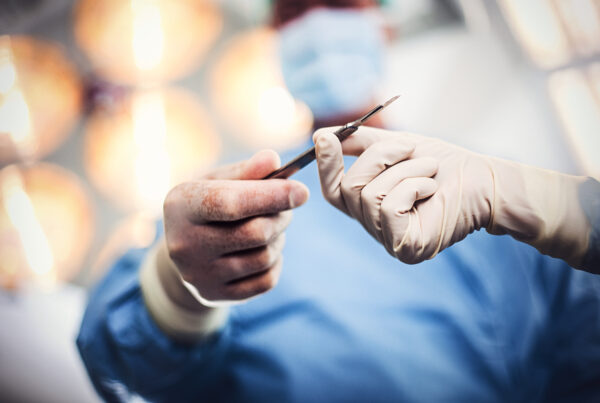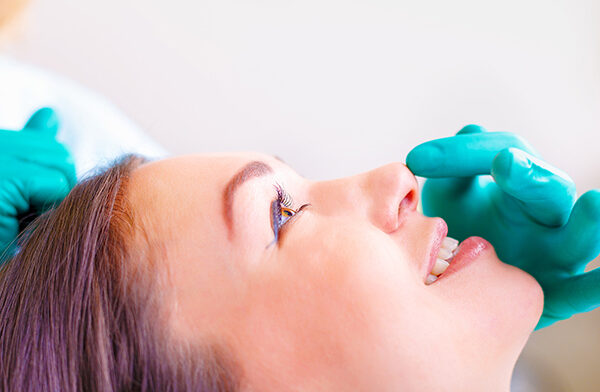we are talking about secondary rhinoplasty: we often find ourselves in front of patients who have undergone primary rhinoplasty.
Sometimes they are not satisfied and come to our attention to perform a correction: therefore there is the need to perform a corrective surgery

when we use secondary rhinoplasty: often too aggressive rhinoplasty leaves results such as hump, tip defects and deviation.
Since we are faced with these cases we propose the open secondary structural rhinoplasty technique:
through the cutaneous access, which is located at the level of the columella, a detachment is performed that allows to respect the delicate anatomical structures of the tip, the alar cartilages, and to have excellent visibility of the nose.
1) What kind of anesthesia is used?
In secondary rhinoplasty we prefer under general anesthesia. This controls blood pressure and reduces the risk of bleeding.

the humb can be reduced in secondary rhinoplasty
2) How long does the surgery last?
the duration od a classical secondary rhinoplasty lasts from two to three to four hours.
It depends on the type of defect we are facing: for example, if a lot of cartilage was removed in the previous rhinoplasty, a cartilage graft will be necessary.
The most frequent graft sampling sites are the nasal septum and rib cartilage

pre and post.
3) when to choose the septum and when the costal cartilage?
It depends: if in rhinoplasty we are faced with sufficient cartilage, the nasal septum remains the first choice. In fact, the septum is very similar to superficial cartilages, it is available and external samples with other scars are avoided.
If, on the other hand, there is no septal cartilage available, because it has been used previously, for example, our first choice is rib cartilage.
For this reason we will perform a sample at the level of the chest, under the sulcus of the breast, with a small scar of about 3-4 cm, which falls in the same location as the access to insert the prostheses in the breast augmentation.
Revision rhinoplasty, also known as corrective rhinoplasty or secondary rhinoplasty, is a nasal procedure performed to correct respiratory problems or cosmetic abnormalities caused or left unresolved by a previous rhinoplasty.
4) What are the benefits of revision rhinoplasty?
Secondary rhinoplasty can be done to help improve the following nasal problems and irregularities:
– Unnatural nasal aspect
– Crooked nasal tip
-Columella suspended or retracted
-Persistent nasal hump
-tip too rotated or under rotated
– Nasal length too short
– obstruction or difficulty breathing
– Saddle nose deformity
-Inverted V-shaped deformity

pre post rhinoplasty profile
For each individual patient, the key goal of revision rhinoplasty is to help restore the nose to balance well with the rest of the facial features, successfully resolving any aesthetic and / or functional problem.
5) Who is a good candidate for revision rhinoplasty?
Good candidates for revision rhinoplasty at our clinic generally include individuals who are dissatisfied with the outcome of a previous nasal procedure, either aesthetically or functionally, or both.
We usually recommend having a secondary rhinoplasty at least 12 months after the first, as this provides enough time for any swelling to resolve completely and the final results of the initial operation to be evident.
Patients will need to arrive with realistic expectations of what can be safe and effective to be achieved.
For this reason, we visit our patients twice before the surgery, in order to view blood tests, study the CT scan, which we recommend before performing the surgery, and establish the final details and unravel the patient’s doubts.

pre and post after rhinoplasty
6) How is the revision rhinoplasty procedure performed?
Revision rhinoplasty is typically performed using incisions made in the same area as the primary rhinoplasty procedure, which helps limit any additional scarring.
This may include making small incisions inside the nostrils (“closed” technique) or applying a small incision in the vertical strip of the nose (“open” technique).
With both approaches, soft tissue, cartilage and bone are meticulously shaped and / or removed until the nasal passages are blocked and the desired contour is achieved.
In some cases, a cartilage graft transferred from the ear and / or rib may be required to achieve an optimal result.
For this reason ,depending on the complexity of the procedure, revision rhinoplasty can usually be completed in about two to three hours, and most people can go home the same day with the help of a close friend or family member.
7) How is the recovery process of revision rhinoplasty?
Immediately following revision rhinoplasty, a nasal brace is usually placed to provide protection for the reshaped nose during the initial stages of healing.
So If a cartilage graft from the ear or rib has been required, associated bandages may also be placed.
Patients will typically have their external nasal splint, as well as any stitches, removed about a week after surgery.
Swelling and bruising are typical side effects after the procedure, but these symptoms are temporary and should gradually resolve on their own.
how much is the recovery time?
Most of our rhinoplasty revision patients return to work and their normal daily routine after about seven days, but all strenuous activities will need to be avoided for several weeks to ensure proper healing.
Although most swelling usually goes away within a week, it may take up to a year for all swelling to go away completely.
To find out more about revision rhinoplasty or if you would like to schedule a consultation at our clinic to find out if this procedure is right for you, contact


